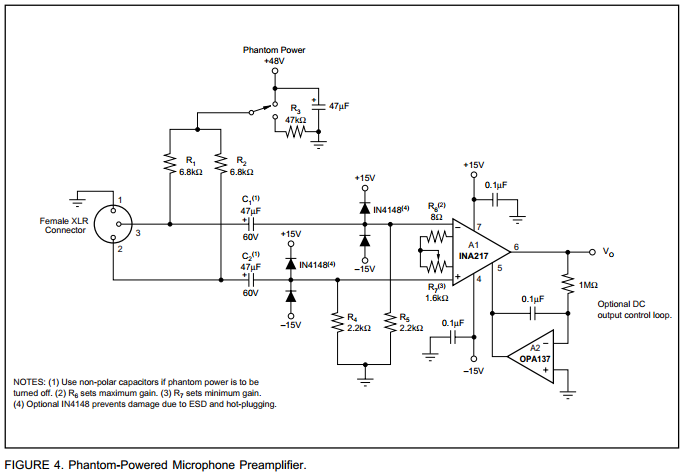samurai1993
New member
- Joined
- Jul 13, 2014
- Messages
- 3
Hi there! I'm working on a little project, implementing the INA217 reference schematic into a stripboard, but my limited knowledge (just basic theoretical electronics, and some soldering experience) has been a real problem. The schematic:

Following the signal path (As I understand it): the INA217 is an instrumentation amp, so an input transformer is not a must for a good result. Then phantom power is injected, but blocked from touching the IC input by those 2 caps in series with the signal, then some diodes for overcharge protection, the IC itself doing the work, and then an unbalanced output.
My questions:
[list type=decimal]
[*]The phantom power has a cap and a resistor besides the switch, going to ground. What is their function? Filtering? In the "off" position why does the connection goes to ground instead of nothing?
[*]The protection diodes, why they go to +15 and -15 instead ground?
[*]I don't quite get the role of R4 and R5, or the 0.1 uF caps going to ground from the power rails
[/list]
And the final one here because it's longer: I don't really get how the DC servo/offset loop works, why is there a 1M resistor, then the parallel cap and the op amp (I've just a little grasp of what a DC offset is, so maybe this doubt is just natural). I've seen some recomendations of just shunting the ref pin to ground and using a good quality output cap; that should work for me, but I still want to know how the servo works.
That's it, sorry for the numerous questions, but I'm just returning to this (I made a some DIY a few years ago), with lots of forgotten stuff and much more that I just never knew. Thanks for your answers!

Following the signal path (As I understand it): the INA217 is an instrumentation amp, so an input transformer is not a must for a good result. Then phantom power is injected, but blocked from touching the IC input by those 2 caps in series with the signal, then some diodes for overcharge protection, the IC itself doing the work, and then an unbalanced output.
My questions:
[list type=decimal]
[*]The phantom power has a cap and a resistor besides the switch, going to ground. What is their function? Filtering? In the "off" position why does the connection goes to ground instead of nothing?
[*]The protection diodes, why they go to +15 and -15 instead ground?
[*]I don't quite get the role of R4 and R5, or the 0.1 uF caps going to ground from the power rails
[/list]
And the final one here because it's longer: I don't really get how the DC servo/offset loop works, why is there a 1M resistor, then the parallel cap and the op amp (I've just a little grasp of what a DC offset is, so maybe this doubt is just natural). I've seen some recomendations of just shunting the ref pin to ground and using a good quality output cap; that should work for me, but I still want to know how the servo works.
That's it, sorry for the numerous questions, but I'm just returning to this (I made a some DIY a few years ago), with lots of forgotten stuff and much more that I just never knew. Thanks for your answers!



